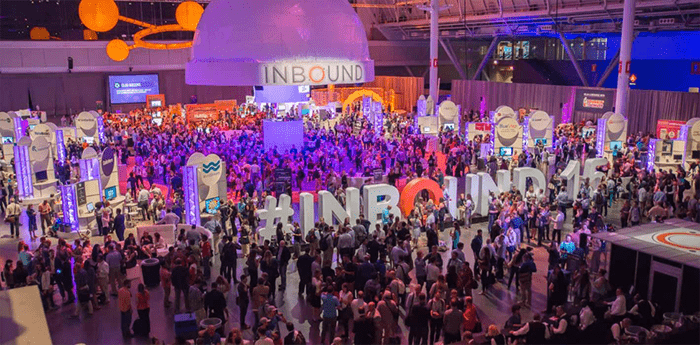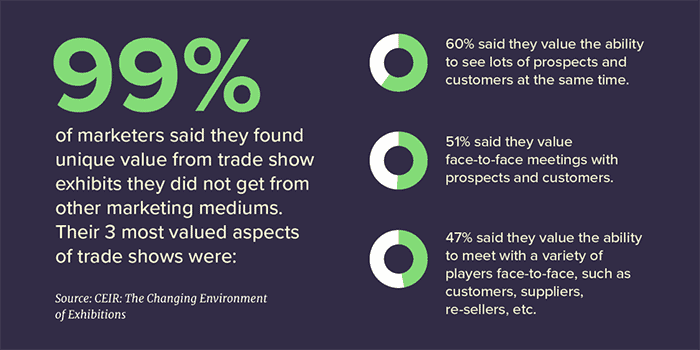In recent years, collecting leads has become a largely online process. However, tradeshows and other events are one of the places where businesses can take advantage of face-to-face time with their potential leads, and that makes it an important marketing opportunity. The golden rule of face to face marketing is this: You are as successful...
In recent years, collecting leads has become a largely online process. However, tradeshows and other events are one of the places where businesses can take advantage of face-to-face time with their potential leads, and that makes it an important marketing opportunity.
The golden rule of face to face marketing is this: You are as successful as the data you collect.
The data you collect at a show or event is varied and useful in a lot of different ways. In this post we discuss how, when, and why you should be collecting data at a tradeshow to make the most of the experience.
Finding the Right Time
When you are marketing person to person, your goal should be to collect the data of every guest you make a personal connection with. This is because the unique context of being at a live event gives you important benefits and information regarding your target audience that online data captures do not. When collecting data, the main thing to consider is the different times to be collecting data and what you should be collecting during each of those times. Do you want to be focusing on data collection before, during or after the event?
Usually, the answer will be all three.

Before the Event
Before the event is a good time to collect data by using the appeal of a raffle or other prize option. You can collect guest’s names and emails and then enter them to win some sort of giveaway, and this is a great way to build excitement for the day and get your company on the event radar early on.
Something to be aware of when capturing data before the event is to not appear to be desperate or come on too strong. As your guests have not gotten to experience your booth or talk to you about your product, you do not want to approach them in an intimidating way right in the beginning. If you don’t have a fun offer like a raffle or giveaway to sugarcoat the ask, then wait until later in the day.
During the Event
During the event is a great time to target potential customers based on who passes by and takes interest in your booth. You should get the name, email, and phone number of anyone who appears interested in your booth because they are perfect candidates for future nurturing campaigns and newsletter recipients. By being in the same place at the same time, offering a legitimate and nicely designed booth display, and talking in person, you have already built an inherent level of trust that will give you a leg up over the less personalized competition that the potential customer may find online. This is the moment to use it.
An example event survey might look like this:
- Name:
- Company Name:
- Position:
- What brought you to this event today?
- What did you know about our company before today’s event?

- What have you learned about our company today?
- Which social media outlet do you use the most? Facebook | Linkedin| Twitter
The first questions are necessary for establishing the demographic of the guest and adding them to any email lists. The questions regarding the company are great to use for feedback and to improve clarifying your message for later tradeshows. The last question is an example of a question you can use to further distinguish your target demographic and sell better to them in the future.

Some things to look out for are remaining authentic, not pushing too hard for information, and being up front about what the data you are collecting is going to be used for. It’s not good practice to take email addresses under false pretenses and then bombard potential customers with emails they never asked for.
After the Event
After the event is the most difficult time to collect information, but it’s one of the most important times. After the event is when you should be trying to get feedback from the guests on the experience as a whole. Post-event surveys that are available on tablets to be passed around, like the tablet surveys available at MyFeelBack, are a popular option for getting feedback directly after an event. Make sure that the tablets have an offline option so that your guests are not dependent on wifi to fill out the survey. (MyFeelBack’s option includes an offline local mode that resyncs the data when connected to wifi.) Whatever you do, make sure the survey is short and easy to fill out so that you get as many responses as possible and don’t frustrate your guests.
An event exit survey might look like this:
- How was your overall experiene of the tradeshow?
- How did (insert your company name) contribute or detract from your overall experience?
- Would you like to hear from (insert your company name) in the future? If so, please leave contact information below:
Click here to discover 7 key points for asking the right questions in your questionnaires

Once You Get Your Data
Collecting data in person is not easy and it’s great if you can accomplish it. However if you don’t actively follow up and nurture the lead or act on the feedback you receive, all of the hard work you put in is a waste of time. Leads that you don’t immediately follow up on are as good as gone. Sure, there is a chance that they will take the initiative to find you themselves, but it’s not likely. Your best bet by far is to get their contact information and send them a personal email immediately after the event saying how pleased you were to meet them. Likewise, feedback that you don’t act on ends up hurting your company. Nobody likes to give feedback just to see it hasn’t been implemented.
Shows and events are some of the best times to collect data on your target demographic, so don’t miss this wonderful opportunity to get to know your customer and your product a little better.
Image source : Deutsche Bank








